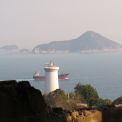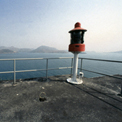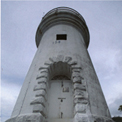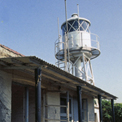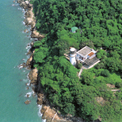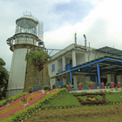Gap Rock
In 1888, after detailed discussions and negotiations, agreement was reached between Britain and China for lighthouses to be built on the two best sites originally chosen to light the approaches to Hong Kong harbour – namely on Gap Rock (Wen-wei Chou) and Waglan Island. At the time, the agreement stipulated that these two small islands were not to be used for any other purpose and they were to remain as Chinese territory.

| Date | 1951 |
| object | lighthouse |
| Material Type | Image |
| Collection | Lighthouses of Hong Kong |
| Source | Hong Kong Museum of History, Ref. No. PC1984.53 |
| Repository | Hong Kong Museum of History |
| Note to Copyright | Permission for use is given by Hong Kong Museum of History |
| Accession No. | LA003.018 |
Gap Rock
In 1888, after detailed discussions and negotiations, agreement was reached between Britain and China for lighthouses to be built on the two best sites originally chosen to light the approaches to Hong Kong harbour – namely on Gap Rock (Wen-wei Chou) and Waglan Island. At the time, the agreement stipulated that these two small islands were not to be used for any other purpose and they were to remain as Chinese territory.
| Date | 1951 |
| Object | lighthouse |
| Material Type | Image |
| Collection | Lighthouses of Hong Kong |
| Source | Hong Kong Museum of History, Ref. No. PC1984.53 |
| Repository | Hong Kong Museum of History |
| Note to Copyright | Permission for use is given by Hong Kong Museum of History |
| Accession No. | LA003.018 |
Gap Rock
In 1888, after detailed discussions and negotiations, agreement was reached between Britain and China for lighthouses to be built on the two best sites originally chosen to light the approaches to Hong Kong harbour – namely on Gap Rock (Wen-wei Chou) and Waglan Island. At the time, the agreement stipulated that these two small islands were not to be used for any other purpose and they were to remain as Chinese territory.
| Date | 1951 |
| Object | lighthouse |
| Material Type | Image |
| Collection | Lighthouses of Hong Kong |
| Source | Hong Kong Museum of History, Ref. No. PC1984.53 |
| Repository | Hong Kong Museum of History |
| Note to Copyright | Permission for use is given by Hong Kong Museum of History |
| Accession No. | LA003.018 |
Gap Rock
In 1888, after detailed discussions and negotiations, agreement was reached between Britain and China for lighthouses to be built on the two best sites originally chosen to light the approaches to Hong Kong harbour – namely on Gap Rock (Wen-wei Chou) and Waglan Island. At the time, the agreement stipulated that these two small islands were not to be used for any other purpose and they were to remain as Chinese territory.
| Date | 1951 |
| Object | lighthouse |
| Material Type | Image |
| Collection | Lighthouses of Hong Kong |
| Source | Hong Kong Museum of History, Ref. No. PC1984.53 |
| Repository | Hong Kong Museum of History |
| Note to Copyright | Permission for use is given by Hong Kong Museum of History |
| Accession No. | LA003.018 |
Gap Rock
In 1888, after detailed discussions and negotiations, agreement was reached between Britain and China for lighthouses to be built on the two best sites originally chosen to light the approaches to Hong Kong harbour – namely on Gap Rock (Wen-wei Chou) and Waglan Island. At the time, the agreement stipulated that these two small islands were not to be used for any other purpose and they were to remain as Chinese territory.
| Date | 1951 |
| Venue | Gap Rock |
| Object | lighthouse |
| Material Type | Image |
| Collection | Lighthouses of Hong Kong |
| Source | Hong Kong Museum of History, Ref. No. PC1984.53 |
| Repository | Hong Kong Museum of History |
| Note to Copyright | Permission for use is given by Hong Kong Museum of History |
| Accession No. | LA003.018 |
Gap Rock
In 1888, after detailed discussions and negotiations, agreement was reached between Britain and China for lighthouses to be built on the two best sites originally chosen to light the approaches to Hong Kong harbour – namely on Gap Rock (Wen-wei Chou) and Waglan Island. At the time, the agreement stipulated that these two small islands were not to be used for any other purpose and they were to remain as Chinese territory.
| Date | 1951 |
| Object | lighthouse |
| Material Type | Image |
| Collection | Lighthouses of Hong Kong |
| Source | Hong Kong Museum of History, Ref. No. PC1984.53 |
| Repository | Hong Kong Museum of History |
| Note to Copyright | Permission for use is given by Hong Kong Museum of History |
| Accession No. | LA003.018 |
Gap Rock
In 1888, after detailed discussions and negotiations, agreement was reached between Britain and China for lighthouses to be built on the two best sites originally chosen to light the approaches to Hong Kong harbour – namely on Gap Rock (Wen-wei Chou) and Waglan Island. At the time, the agreement stipulated that these two small islands were not to be used for any other purpose and they were to remain as Chinese territory.
| Date | 1951 |
| Object | lighthouse |
| Material Type | Image |
| Collection | Lighthouses of Hong Kong |
| Source | Hong Kong Museum of History, Ref. No. PC1984.53 |
| Repository | Hong Kong Museum of History |
| Note to Copyright | Permission for use is given by Hong Kong Museum of History |
| Accession No. | LA003.018 |
Gap Rock
In 1888, after detailed discussions and negotiations, agreement was reached between Britain and China for lighthouses to be built on the two best sites originally chosen to light the approaches to Hong Kong harbour – namely on Gap Rock (Wen-wei Chou) and Waglan Island. At the time, the agreement stipulated that these two small islands were not to be used for any other purpose and they were to remain as Chinese territory.
| Date of Death | 1951 |
| Object | lighthouse |
| Material Type | Image |
| Collection | Lighthouses of Hong Kong |
| Source | Hong Kong Museum of History, Ref. No. PC1984.53 |
| Repository | Hong Kong Museum of History |
| Note to Copyright | Permission for use is given by Hong Kong Museum of History |
| Accession No. | LA003.018 |
Gap Rock
In 1888, after detailed discussions and negotiations, agreement was reached between Britain and China for lighthouses to be built on the two best sites originally chosen to light the approaches to Hong Kong harbour – namely on Gap Rock (Wen-wei Chou) and Waglan Island. At the time, the agreement stipulated that these two small islands were not to be used for any other purpose and they were to remain as Chinese territory.
| Date | 1951 |
| Material Type | Image |
| Collection | Lighthouses of Hong Kong |
| Source | Hong Kong Museum of History, Ref. No. PC1984.53 |
| Note to Copyright | Permission for use is given by Hong Kong Museum of History |
| Accession No. | LA003.018 |
Gap Rock
In 1888, after detailed discussions and negotiations, agreement was reached between Britain and China for lighthouses to be built on the two best sites originally chosen to light the approaches to Hong Kong harbour – namely on Gap Rock (Wen-wei Chou) and Waglan Island. At the time, the agreement stipulated that these two small islands were not to be used for any other purpose and they were to remain as Chinese territory.
| Date | 1951 |
| Material Type | Image |
| Object | lighthouse |
| Collection | Lighthouses of Hong Kong |
| Source | Hong Kong Museum of History, Ref. No. PC1984.53 |
| Repository | Hong Kong Museum of History |
| Note to Copyright | Permission for use is given by Hong Kong Museum of History |
| Accession No. | LA003.018 |
Gap Rock
In 1888, after detailed discussions and negotiations, agreement was reached between Britain and China for lighthouses to be built on the two best sites originally chosen to light the approaches to Hong Kong harbour – namely on Gap Rock (Wen-wei Chou) and Waglan Island. At the time, the agreement stipulated that these two small islands were not to be used for any other purpose and they were to remain as Chinese territory.
| Date | 1951 |
| Object | lighthouse |
| Material Type | Image |
| Collection | Lighthouses of Hong Kong |
| Source | Hong Kong Museum of History, Ref. No. PC1984.53 |
| Repository | Hong Kong Museum of History |
| Note to Copyright | Permission for use is given by Hong Kong Museum of History |
| Accession No. | LA003.018 |
Gap Rock
In 1888, after detailed discussions and negotiations, agreement was reached between Britain and China for lighthouses to be built on the two best sites originally chosen to light the approaches to Hong Kong harbour – namely on Gap Rock (Wen-wei Chou) and Waglan Island. At the time, the agreement stipulated that these two small islands were not to be used for any other purpose and they were to remain as Chinese territory.
| Date | 1951 |
| Object | lighthouse |
| Material Type | Image |
| Collection | Lighthouses of Hong Kong |
| Source | Hong Kong Museum of History, Ref. No. PC1984.53 |
| Repository | Hong Kong Museum of History |
| Note to Copyright | Permission for use is given by Hong Kong Museum of History |
| Accession No. | LA003.018 |
Gap Rock
In 1888, after detailed discussions and negotiations, agreement was reached between Britain and China for lighthouses to be built on the two best sites originally chosen to light the approaches to Hong Kong harbour – namely on Gap Rock (Wen-wei Chou) and Waglan Island. At the time, the agreement stipulated that these two small islands were not to be used for any other purpose and they were to remain as Chinese territory.
| Date | 1951 |
| Object | lighthouse |
| Material Type | Image |
| Collection | Lighthouses of Hong Kong |
| Source | Hong Kong Museum of History, Ref. No. PC1984.53 |
| Repository | Hong Kong Museum of History |
| Note to Copyright | Permission for use is given by Hong Kong Museum of History |
| Accession No. | LA003.018 |
Gap Rock
In 1888, after detailed discussions and negotiations, agreement was reached between Britain and China for lighthouses to be built on the two best sites originally chosen to light the approaches to Hong Kong harbour – namely on Gap Rock (Wen-wei Chou) and Waglan Island. At the time, the agreement stipulated that these two small islands were not to be used for any other purpose and they were to remain as Chinese territory.
| Date | 1951 |
| Object | lighthouse |
| Material Type | Image |
| Collection | Lighthouses of Hong Kong |
| Source | Hong Kong Museum of History, Ref. No. PC1984.53 |
| Repository | Hong Kong Museum of History |
| Note to Copyright | Permission for use is given by Hong Kong Museum of History |
| Accession No. | LA003.018 |
Gap Rock
In 1888, after detailed discussions and negotiations, agreement was reached between Britain and China for lighthouses to be built on the two best sites originally chosen to light the approaches to Hong Kong harbour – namely on Gap Rock (Wen-wei Chou) and Waglan Island. At the time, the agreement stipulated that these two small islands were not to be used for any other purpose and they were to remain as Chinese territory.
| Date | 1951 |
| Object | lighthouse |
| Material Type | Image |
| Collection | Lighthouses of Hong Kong |
| Source | Hong Kong Museum of History, Ref. No. PC1984.53 |
| Repository | Hong Kong Museum of History |
| Note to Copyright | Permission for use is given by Hong Kong Museum of History |
| Accession No. | LA003.018 |
Gap Rock
In 1888, after detailed discussions and negotiations, agreement was reached between Britain and China for lighthouses to be built on the two best sites originally chosen to light the approaches to Hong Kong harbour – namely on Gap Rock (Wen-wei Chou) and Waglan Island. At the time, the agreement stipulated that these two small islands were not to be used for any other purpose and they were to remain as Chinese territory.
| Date | 1951 |
| Object | lighthouse |
| Material Type | Image |
| Collection | Lighthouses of Hong Kong |
| Source | Hong Kong Museum of History, Ref. No. PC1984.53 |
| Repository | Hong Kong Museum of History |
| Note to Copyright | Permission for use is given by Hong Kong Museum of History |
| Accession No. | LA003.018 |
Gap Rock
In 1888, after detailed discussions and negotiations, agreement was reached between Britain and China for lighthouses to be built on the two best sites originally chosen to light the approaches to Hong Kong harbour – namely on Gap Rock (Wen-wei Chou) and Waglan Island. At the time, the agreement stipulated that these two small islands were not to be used for any other purpose and they were to remain as Chinese territory.
| Date | 1951 |
| Object | lighthouse |
| Material Type | Image |
| Collection | Lighthouses of Hong Kong |
| Source | Hong Kong Museum of History, Ref. No. PC1984.53 |
| Repository | Hong Kong Museum of History |
| Note to Copyright | Permission for use is given by Hong Kong Museum of History |
| Accession No. | LA003.018 |
Gap Rock
In 1888, after detailed discussions and negotiations, agreement was reached between Britain and China for lighthouses to be built on the two best sites originally chosen to light the approaches to Hong Kong harbour – namely on Gap Rock (Wen-wei Chou) and Waglan Island. At the time, the agreement stipulated that these two small islands were not to be used for any other purpose and they were to remain as Chinese territory.
| Date | 1951 |
| Object | lighthouse |
| Material Type | Image |
| Collection | Lighthouses of Hong Kong |
| Source | Hong Kong Museum of History, Ref. No. PC1984.53 |
| Repository | Hong Kong Museum of History |
| Note to Copyright | Permission for use is given by Hong Kong Museum of History |
| Accession No. | LA003.018 |
Copyright © 2012 Hong Kong Memory


